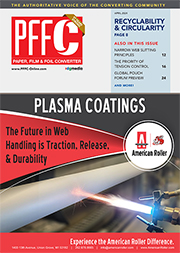Featured Stories
-
Innovation in Extrusion Barriers Can Reduce Brand Owners’ Dependence on Plastic
According to the most recent statistics from the Environmental Protection Agency1, in 2018 the U.S. produced 35 million tons of plastics, while... -
Tension: The First Thing We Must Get Right
Web tension is arguably the most important parameter for any web process. Tension is the first thing we must get right. -
Principles of Narrow Web Slitting
For those veterans in the slitting-winding community, this commentary is not necessarily new information, but reviews are always good too.
News | New Products
-
TIPA Compostable Packaging Appoints John Wilson as Commercial Director for North America
Packaging and sustainability industry veteran joins TIPA, to drive US adoption of compostable packaging to curb plastic waste
-
INX promotes three to Vice President positions
The Board of Directors at INX International Ink Co. have approved the promotions of three key executive managers to vice president positions.
-
Rogelio Barba Villagran Named Business Development Director for AGH Labels North America
AGH Labels, headquartered in Leon, Mexico, is excited to announce long-time executive, Rogelio Barba Villagran, as its business development director for AGH Labels North America.
-
Hong Kong PrintPack Fairs Open in April
Jointly organized by the Hong Kong Trade Development Council and CIEC Exhibition Company (HK) Limited, the two PrintPack Fairs will be April 27-30, 2024 at AsiaWorld-Expo
-
BioEmitter®- Keeping Corrosion and Rust at Bay in Enclosed Spaces
One of the most important missions of Cortec® Corporation, a global leader in the corrosion protection industry, is environmental responsibility.
-
Fedrigoni Names New Commercial Senior Vice President, Chief Marketing Officer
Fedrigoni — the world’s leading manufacturer of specialty papers, premium self-adhesive materials, RFID and connected solutions
-
SEI integrates Vetaphone on new Labelmaster KyoJet
SEI Laser Converting is based in Buja in the northeast corner of Italy.
Expert Advice
History, Shellfish, Royalty, and the Color Purple
- Published: July 01, 2002, By Dr. Richard M. Podhajny, Ph.D. Contributing Editor
Understanding color is one of the keys to success in the printing industry. It also can be very interesting history.
A dictionary defines purple as “any of a group of colors with a hue between that of violet and red” and as a “symbol of royalty or high office.” Historically, the color purple has been associated with royalty and power, but the secret of its power lies in the glands of tiny shellfish creatures.
The earliest archaeological evidence for the origins of purple dyes points to the Minoan civilization in Crete, about 1900 B.C. The ancient land of Canaan (its corresponding Greek name was Phoenicia, which means “land of the purple”) was the center of the ancient purple dye industry.
“Tyrian Purple,” the purple dye of the ancients mentioned in texts dating back to about 1600 B.C., was produced from the mucus of the hypobranchial gland of various species of marine mollusks, notably Murex. It took some 12,000 shellfish to extract 1.5 grams of the pure dye. Legend credits its discovery to Herakles, or rather to his dog, whose mouth was stained purple from chewing on snails along the Levantine coast. King Phoenix received a purple-dyed robe from Herakles and decreed the rulers of Phoenicia should wear this color as a royal symbol.
Although originating in Tyre (hence the name), man's first dye chemical industry spread throughout the world.
Rome, Egypt, and Persia all used purple as the imperial standard. Purple dyes were rare and expensive; only the rich had access to them. The purple colorants used came from different sources, most from the dye extraction from fish or insects.
The imperial purple of Rome was based on mollusk from which purpura comes. Emperor Aurelian refused to let his wife buy a purpura-dyed silk garment, as it cost its weight in gold!
Insect and snail animal-based colors were mentioned in the Bible for use in textile furnishings of the Tabernacle and for the sacred vestments for the High Priest Aaron, and they also were used in King Solomon's and King Herod's temples in Jerusalem.
With the decline of the Roman Empire, the use of “Tyrian Purple” also declined, and large-scale production ceased with the fall of Constantinople in 1453 A.D. It was replaced by cheaper dyes such as lichen purple and madder.
Pope Paul II in 1464 introduced the so-called “Cardinal's Purple,” which was really scarlet extracted from the Kermes insect. This became the first luxury dye of the Middle Ages.
Dyes were exported extensively from Central and South America during Spain's exploration of North and South America. Among these were Cochineal from Mexico and Peru.
The chemical birth of the synthetic dye industry can be traced to the discovery of an aniline-based purple dye, mauveine, by William H. Perkin in 1856, who accomplished this while searching for a cure for malaria. Perkin was an English chemist who changed the world of his time by making this purple color available to the masses. It became quite fashionable to wear clothing dyed with “mauve,” and Mr. Perkin became a very wealthy man.
In 1909 Paul Friedlander determined the major chemical composition of Murex dye as 6,6'-dibromoindigo.
Today, genuine “Tyrian Purple” remains the domain of the rich and famous. However, synthetic dyes and pigments that meet various purple color requirements have removed the mystique of the color purple.
Editor's Note: Mars Inc. will add purple to the mix of colors for its M&M's candies next month.
Dr. Richard M. Podhajny has been in the packaging and printing industry for more than 30 years. Contact him at 215/616-6314; This email address is being protected from spambots. You need JavaScript enabled to view it..













